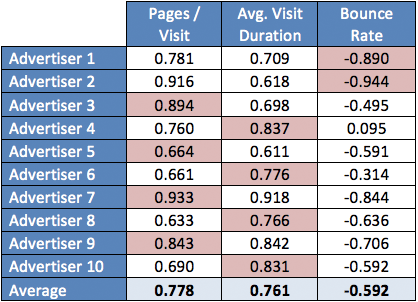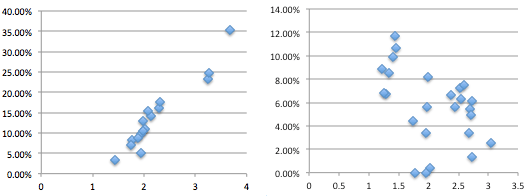Can engagement metrics be used as a proxy for conversion rate when optimizing advertising campaigns?
When we manage advertising campaigns, whether they be in Google Ads, Facebook, or elsewhere, we strive to drive as many leads or sales as possible. Doing this usually includes setting bids or budgets based on an expected conversion rate. For example, if keyword A converts at twice the rate of keyword B, we should be willing to pay twice as much for keyword A. There’s a lot more to it than that, but that’s the basic idea.
Ideally, we have enough historical data for keywords A and B to derive accurate conversion rate estimates, but this is often not the case. One of the techniques we use when we are short on data is to look at an engagement metric as a proxy for conversion rate, the idea being that engaged visitors are more likely to convert. Engagement metrics such as time on site, page views per visit and bounce rate are built into Google Analytics, so are often available when conversion data is insufficient. The other good thing about engagement data is that it accumulates a lot faster than conversion data. For example, after 100 visits you can probably get a decent estimate of average visit duration, while 100 visits will result in a very small number of conversions for most advertisers, not enough to make a good estimate.
We’ve been optimizing with engagement metrics for a while, but had never properly validated which metrics work best. A few days ago, while building an optimization model for a client, I decided it was time to rectify this. Below are the results of my analysis.
A Correlation Between Engagement Metrics and Conversion Rate for 10 Advertisers

The ten advertisers I selected span a range of verticals. The numerical fields represent the correlation between the metric at the top of the column and conversion rate. The metric with the highest correlation has been highlighted for each advertiser. I looked at the 10 highest-volume keywords for each advertiser to do the correlation. For example, for Advertiser 1’s top ten keywords, Pages/Visit, and conversion rate have a correlation of 0.781. Measurements of correlation range between -1 and 1. A correlation of 1 means that two sets of values correlate perfectly. If I know one value, I can infer the other. A correlation of -1 also means that two values correlate perfectly, but one goes up while the other goes down. In the data I collected, bounce rate generally has a negative correlation to conversion rate, because a lower bounce rate means higher engagement. A correlation of 0 means that the two values don’t correlate at all. Knowing one tells me nothing about the other. Correlations close to zero generally mean that two sets of data have no relationship, while correlations close to 1 or -1 imply a strong relationship.
What do my results mean?
The main things I learned from my analysis were that engagement does tend to correlate to conversion rate, and that no single metric correlates best. I was hoping to find that one of the metrics I chose would consistently have the strongest correlation, but no joy. For the most part, Pages/Visit and Visit Duration correlate about the same, but sometimes one or the other correlates much better. In a few cases bounce rate correlated best, but in others bounce rate didn’t correlate at all. Based on my analysis, Pages/Visit is the best proxy for conversion rate, but my sample is too small to say this conclusively. Going forward, I plan on doing an analysis like this for each advertiser we work with before deciding which metric to use as a proxy. If I have insufficient conversion data, I’ll use Pages/Visit.
In the cases where overall correlation was low, one of two things tended to be the case:
- I didn’t have statistically significant conversion data. In all cases, I had tens of thousands of clicks to analyze, but even that was not enough to derive a statistically significant estimate of conversion rate for some advertiser keywords.
- There were multiple paths to conversion with varying complexity. For example, if some visitors convert on a landing page, and others convert after navigating through a site, engagement will not correlate very well to conversion rate.
I did also exclude a few advertisers where engagement and conversion rate didn’t correlate at all. Below are two different advertisers, and visualizations of the correlation between Pages/Visit (the X axis) and conversion rate (the Y axis) for each. For the advertiser on the left, conversion rate tends to go up as Pages/Visit goes up. For the advertiser on the right, there appears to be no relationship between the two.

I’d love to hear your thoughts on engagement as a proxy for conversion rate, and any other tricks you have for optimizing when conversion data is sparse.
Nico Brooks is a data geek who struggles to get his head around marketing problems, but he always enjoys the struggle. Two Octobers is an internet marketing company that provides digital marketing services with a strong focus on data-driven optimization and measurable results.





Great post!
I was really looking for what you proposed.
I´m traying to find conversion rates in countries where my company hasn´t been it, yet, but it´s incredibly difficult. That´s why I´m looking for proxies of CR and I´m trying with what you proposed.
Bests!
[…] procedures for tax returns […]
[…] is not as beautiful and lovely, A beautiful mind, as the first productivity, Zhao Yanyun points out,A good exchange of experience in learning experien, I believe that through the efforts, […]
[…] Guangdong to the affected areas of Yunnan Yingjiang donated […]
[…] The Bureau of Meteorology said Since the beginning of the 21 […]